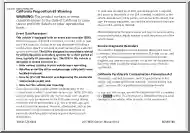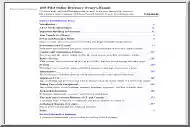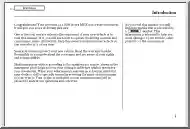No comments yet. You can be the first!
Content extract
Clinical Endodontic Tips By Edward F. Rosenfeld, DMD, MS Disclaimer: These guidelines are presented for the benefit of dentists who wish to expand their endodontic knowledge. Practitioners must always use their best professional judgment, taking into account the needs of each individual patient. Antibiotic Use and Misuse Your patient complains of a toothache which is intensified by cold liquids. The tooth is percussion sensitive and a thickening of the PDL is present. A carious lesion is evident which extends into the pulp. The patient is NOT medically compromised Do you prescribe an antibiotic? This condition clearly DOES NOT call for the use of antibiotics yet we still see patients arriving for emergency treatment with a new prescription for Penicillin or some other antibiotic. The situation above concerns a vital pulp. There are few, if any, bacteria present in the pulp The proper treatment is to perform emergency endodontic therapy or complete single-visit endodontic therapy,
prescribe an analgesic such as Ibuprofen and provide reassurance to the patient. There is currently an antibiotic crisis in this country as a result of misuse and overuse. Low doses of antibiotics are present in the food we eat. The result of the above is antibiotic resistance New strains are mutating faster than the drug companies can develop new antibiotics. Let us not contribute to the problem by prescribing them when they are not indicated or by prescribing the wrong drug or an inappropriate dose when they are indicated. These are some other endodontic situations where it is inappropriate to prescribe antibiotics: • Non-vital pulp with a chronic, draining sinus tract (fistula). • Non-vital pulp in a healthy patient without any swelling. • The proper treatment is to remove the pulp through thorough debridement. • If you wish to place an intracanal medicament, you may use Calcium Hydroxide or Vitapex. • Single-visit endodontics may also be performed. What situations may or
may not call for the use of antibiotics? • • • Non-vital pulp with good drainage upon opening the tooth. Non-vital pulp with fluctuant swelling where an incision and drainage is performed. Re-treatment of a failing root canal treatment. These situations most often require appropriate antibiotic coverage: • • • • Pre-medication situations, ie: cardiac prophylaxis Non-vital pulp in a medically compromised patient. Non-vital pulp with an indurated, non-fluctuant swelling. Post-treatment swelling. In these situations often there is a fever present of greater than 100 degrees Fo, malaise, lymphadenopathy and trismus may also be present. What is the first line for empiric antibiotic therapy? • • • Penicillin VK 500 mg q 4-6 h (1000 mg loading dose) Narrowest spectrum Amoxicillin 500 mg q 8 h (1000 mg loading dose) Broader spectrum and less desirable. Azithromycin (Zithromax) 250 mg q24h (500 mg loading dose) for milder infections. If a patient is allergic to or not
responding to the above, the second line is: • • Add Metronidazole (Flagyl) 500 mg q6h (1000 mg loading dose) to Pen VK or change to: Clindamycin (Cleocin) 300 mg q6h (600 mg loading dose) Any antibiotic therapy should be continued for three days after the major signs and symptoms have disappeared. For additional information on this important subject, please feel free to e-mail Dr Rosenfeld and request the AAE publication on this topic. (drr@milehighendocom) MTA (Mineral Trioxide Aggregate) Mineral Trioxide Aggregate or MTA is the new wonder drug in endodontics. It has shown significant improvement over other materials in promoting the healing of pulp and periradicular tissues and some of these applications will be discussed below. MTA has been developed by researchers at the Department of Endodontics at Loma Linda University. Over the last five years it has undergone extensive scientific testing and numerous articles documenting this research have been published in the Journal
of Endodontics and in other periodicals. Long-term clinical studies are planned Pulp capping has traditionally been performed with Calcium Hydroxide. MTA has now been shown to be more effective. It prevents bacterial leakage, is biocompatible and is effective in a moist environment. When placed over vital uninflamed tissue, it actually stimulates the formation of dentin. The ideal situation is capping a young tooth with an incompletely formed root and an apical diameter of one mm or more. It is essential that teeth be free of irreversible inflammation Endodontic therapy is indicated in the presence of large carious exposures or with teeth exhibiting spontaneous pain and/or lingering pain to thermal testing. Another application for MTA is for root-end filling. It is technique sensitive and can be washed out easily with a saline rinse. Perforation repair is becoming somewhat more predictable with MTA than with other materials such as Ketac Silver, amalgam, IRM, or Gerestore. The key is
to repair these defects early, before bone destruction has occurred. If a lesion has developed, the prognosis is poor regardless of the material used to repair the defect. Another key is to use a matrix to prevent the extrusion of the material into the periradicular spaces. MTA may be used to repair perforations in the furcation, coronal, mid or apical portion of the root. It must be kept moist but not wet and may be covered by amalgam or Gerestore. Another indication is to repair resorptive perforations, if not too extensive. It will be interesting to see the research regarding the combined use of MTA and guided tissue regeneration techniques, perhaps with Atrisorb (Block Drug). Even with MTA, the surgical repair of post perforations is unpredictable unless the post is removed and the repair is made internally. Its use is contraindicated for vertical fractures The prognosis in that situation is poor MTA has been approved by the FDA for many of these applications. It is now
available from Dentsply/Tulsa in a kit for $349. (1-800-662-1202 X126) Coronal Leakage The very best endodontic result is only as good as the coronal seal or the definitive restoration. This problem has often been overlooked in the presence of a well-filled root canal. What is coronal leakage? It is the intrusion of bacterial contaminants into a previously clean, well obturated, endodontic filling necessitating endodontic retreatment, surgery, a combination of the two or extraction of the involved tooth. What are the causes of coronal leakage? • • • • • Patient non-compliance, delay in getting a definitive restoration Recurrent decay Loose or missing crown Loose post/crown GP exposed to saliva for more than two weeks Coronal Leakage Studies This subject has been investigated extensively using dye, saliva, bacteria and endotoxin under a variety of conditions such as type of GP filling technique, type of sealer, presence of a post and with or without a coronal seal. The
conclusions reached was that all GP fillings were re-contaminated from in as little as a few days to several weeks. A seal over the Gutta Percha was essential to delay leakage. The form of this seal could be intact Cavit, amalgam, a bonded composite or some definitive restoration. For post prepared teeth, the degree of leakage was proportional to the remaining amount of gutta percha left in the canal. For example, 9 mm of GP below the post leaked less than 5 mm. Preventing Coronal Leakage In an ideal world, every endodontic treatment should be followed by a definitive restoration at the same appointment. Unfortunately, this is not always practical for most general dentists, nor is it possible when an endodontist refers the patient back to his/her dentist for the restorative. If the access cavity is small and the patient is compliant, Cavit is a suitable interim restoration for up to six weeks. If the defect is extensive, a seal should be placed over the Gutta Percha There is no
perfect material yet as dentin bonding is not foolproof and it may be adversely affected by the sealer. Ideally, the material should be colored so as to contrast with the tooth color. It should be placed 3 mm into the canals. Although such a seal may prevent coronal leakage between appointments, the material may interfere with the planned restorative treatment such as post hole preparation and placement. Awareness of this perplexing problem is the first step towards prevention. Patients must accept some of the responsibility in following through with recommended treatment. Practitioners must not restore a tooth exhibiting radiographically successful endodontics where the Gutta Percha has been exposed to saliva directly or via recurrent decay for more than two weeks without first retreating the root canal system. "An Endodontists Thoughts Regarding the Referral of Endodontic Misadventures" (Reproduced with permission from the Dentists Professional Liability Trust of Colorado
Newsletter) Regarding the Patient: Always inform the patient of the file separation. There are usually ways to retrieve the instrument using microscopic visualization and instrumentation. Insurance should never be filed until the procedure is completed, but if it has been and you plan to refer, immediately reverse the claim. Always practice new instrumentation techniques on extracted teeth first No new endodontic technique is quick and easy; never abandon the old techniques of proper straight line access and opening the canals a bit with the Gates Glidden drills. All rotary files should be disposed of after each procedure. Always use the proper length file for the patients mouth opening Regarding the endodontist to whom the patient is referred: Always be honest. Talk with the endodontist yourself and explain the incident. This type of case should not be a surprise Dont make payment complicated. Either offer to pay for the treatment in advance or offer to make the copayment Dont make
the endodontist bill you or force them to involve the patient in payment Dont expect the endodontist to receive no fee. Instrument retrieval and re-treatment to teeth that have had endodontics begun are very difficult procedures. The ultrasonic instruments are $10000 each and many times cannot be used again. Endodontists are, in general, happy to help, but misadventures can result in a compromised outcome which must be accepted. These cases may require routine follow-up exams or additional treatment in the future. Specialists are reluctant to treat misadventures when this is the only type of case referred by someone. These cases are hard, often unrewarding and patient management can be challenging. Edward F. Rosenfeld, DMD, MS, PC 3545 South Tamarac Dr. Suite #220 Denver, CO 80237 (303) 770-8141 http://www.milehighendocom drr@milehighendo.com
prescribe an analgesic such as Ibuprofen and provide reassurance to the patient. There is currently an antibiotic crisis in this country as a result of misuse and overuse. Low doses of antibiotics are present in the food we eat. The result of the above is antibiotic resistance New strains are mutating faster than the drug companies can develop new antibiotics. Let us not contribute to the problem by prescribing them when they are not indicated or by prescribing the wrong drug or an inappropriate dose when they are indicated. These are some other endodontic situations where it is inappropriate to prescribe antibiotics: • Non-vital pulp with a chronic, draining sinus tract (fistula). • Non-vital pulp in a healthy patient without any swelling. • The proper treatment is to remove the pulp through thorough debridement. • If you wish to place an intracanal medicament, you may use Calcium Hydroxide or Vitapex. • Single-visit endodontics may also be performed. What situations may or
may not call for the use of antibiotics? • • • Non-vital pulp with good drainage upon opening the tooth. Non-vital pulp with fluctuant swelling where an incision and drainage is performed. Re-treatment of a failing root canal treatment. These situations most often require appropriate antibiotic coverage: • • • • Pre-medication situations, ie: cardiac prophylaxis Non-vital pulp in a medically compromised patient. Non-vital pulp with an indurated, non-fluctuant swelling. Post-treatment swelling. In these situations often there is a fever present of greater than 100 degrees Fo, malaise, lymphadenopathy and trismus may also be present. What is the first line for empiric antibiotic therapy? • • • Penicillin VK 500 mg q 4-6 h (1000 mg loading dose) Narrowest spectrum Amoxicillin 500 mg q 8 h (1000 mg loading dose) Broader spectrum and less desirable. Azithromycin (Zithromax) 250 mg q24h (500 mg loading dose) for milder infections. If a patient is allergic to or not
responding to the above, the second line is: • • Add Metronidazole (Flagyl) 500 mg q6h (1000 mg loading dose) to Pen VK or change to: Clindamycin (Cleocin) 300 mg q6h (600 mg loading dose) Any antibiotic therapy should be continued for three days after the major signs and symptoms have disappeared. For additional information on this important subject, please feel free to e-mail Dr Rosenfeld and request the AAE publication on this topic. (drr@milehighendocom) MTA (Mineral Trioxide Aggregate) Mineral Trioxide Aggregate or MTA is the new wonder drug in endodontics. It has shown significant improvement over other materials in promoting the healing of pulp and periradicular tissues and some of these applications will be discussed below. MTA has been developed by researchers at the Department of Endodontics at Loma Linda University. Over the last five years it has undergone extensive scientific testing and numerous articles documenting this research have been published in the Journal
of Endodontics and in other periodicals. Long-term clinical studies are planned Pulp capping has traditionally been performed with Calcium Hydroxide. MTA has now been shown to be more effective. It prevents bacterial leakage, is biocompatible and is effective in a moist environment. When placed over vital uninflamed tissue, it actually stimulates the formation of dentin. The ideal situation is capping a young tooth with an incompletely formed root and an apical diameter of one mm or more. It is essential that teeth be free of irreversible inflammation Endodontic therapy is indicated in the presence of large carious exposures or with teeth exhibiting spontaneous pain and/or lingering pain to thermal testing. Another application for MTA is for root-end filling. It is technique sensitive and can be washed out easily with a saline rinse. Perforation repair is becoming somewhat more predictable with MTA than with other materials such as Ketac Silver, amalgam, IRM, or Gerestore. The key is
to repair these defects early, before bone destruction has occurred. If a lesion has developed, the prognosis is poor regardless of the material used to repair the defect. Another key is to use a matrix to prevent the extrusion of the material into the periradicular spaces. MTA may be used to repair perforations in the furcation, coronal, mid or apical portion of the root. It must be kept moist but not wet and may be covered by amalgam or Gerestore. Another indication is to repair resorptive perforations, if not too extensive. It will be interesting to see the research regarding the combined use of MTA and guided tissue regeneration techniques, perhaps with Atrisorb (Block Drug). Even with MTA, the surgical repair of post perforations is unpredictable unless the post is removed and the repair is made internally. Its use is contraindicated for vertical fractures The prognosis in that situation is poor MTA has been approved by the FDA for many of these applications. It is now
available from Dentsply/Tulsa in a kit for $349. (1-800-662-1202 X126) Coronal Leakage The very best endodontic result is only as good as the coronal seal or the definitive restoration. This problem has often been overlooked in the presence of a well-filled root canal. What is coronal leakage? It is the intrusion of bacterial contaminants into a previously clean, well obturated, endodontic filling necessitating endodontic retreatment, surgery, a combination of the two or extraction of the involved tooth. What are the causes of coronal leakage? • • • • • Patient non-compliance, delay in getting a definitive restoration Recurrent decay Loose or missing crown Loose post/crown GP exposed to saliva for more than two weeks Coronal Leakage Studies This subject has been investigated extensively using dye, saliva, bacteria and endotoxin under a variety of conditions such as type of GP filling technique, type of sealer, presence of a post and with or without a coronal seal. The
conclusions reached was that all GP fillings were re-contaminated from in as little as a few days to several weeks. A seal over the Gutta Percha was essential to delay leakage. The form of this seal could be intact Cavit, amalgam, a bonded composite or some definitive restoration. For post prepared teeth, the degree of leakage was proportional to the remaining amount of gutta percha left in the canal. For example, 9 mm of GP below the post leaked less than 5 mm. Preventing Coronal Leakage In an ideal world, every endodontic treatment should be followed by a definitive restoration at the same appointment. Unfortunately, this is not always practical for most general dentists, nor is it possible when an endodontist refers the patient back to his/her dentist for the restorative. If the access cavity is small and the patient is compliant, Cavit is a suitable interim restoration for up to six weeks. If the defect is extensive, a seal should be placed over the Gutta Percha There is no
perfect material yet as dentin bonding is not foolproof and it may be adversely affected by the sealer. Ideally, the material should be colored so as to contrast with the tooth color. It should be placed 3 mm into the canals. Although such a seal may prevent coronal leakage between appointments, the material may interfere with the planned restorative treatment such as post hole preparation and placement. Awareness of this perplexing problem is the first step towards prevention. Patients must accept some of the responsibility in following through with recommended treatment. Practitioners must not restore a tooth exhibiting radiographically successful endodontics where the Gutta Percha has been exposed to saliva directly or via recurrent decay for more than two weeks without first retreating the root canal system. "An Endodontists Thoughts Regarding the Referral of Endodontic Misadventures" (Reproduced with permission from the Dentists Professional Liability Trust of Colorado
Newsletter) Regarding the Patient: Always inform the patient of the file separation. There are usually ways to retrieve the instrument using microscopic visualization and instrumentation. Insurance should never be filed until the procedure is completed, but if it has been and you plan to refer, immediately reverse the claim. Always practice new instrumentation techniques on extracted teeth first No new endodontic technique is quick and easy; never abandon the old techniques of proper straight line access and opening the canals a bit with the Gates Glidden drills. All rotary files should be disposed of after each procedure. Always use the proper length file for the patients mouth opening Regarding the endodontist to whom the patient is referred: Always be honest. Talk with the endodontist yourself and explain the incident. This type of case should not be a surprise Dont make payment complicated. Either offer to pay for the treatment in advance or offer to make the copayment Dont make
the endodontist bill you or force them to involve the patient in payment Dont expect the endodontist to receive no fee. Instrument retrieval and re-treatment to teeth that have had endodontics begun are very difficult procedures. The ultrasonic instruments are $10000 each and many times cannot be used again. Endodontists are, in general, happy to help, but misadventures can result in a compromised outcome which must be accepted. These cases may require routine follow-up exams or additional treatment in the future. Specialists are reluctant to treat misadventures when this is the only type of case referred by someone. These cases are hard, often unrewarding and patient management can be challenging. Edward F. Rosenfeld, DMD, MS, PC 3545 South Tamarac Dr. Suite #220 Denver, CO 80237 (303) 770-8141 http://www.milehighendocom drr@milehighendo.com




 When reading, most of us just let a story wash over us, getting lost in the world of the book rather than paying attention to the individual elements of the plot or writing. However, in English class, our teachers ask us to look at the mechanics of the writing.
When reading, most of us just let a story wash over us, getting lost in the world of the book rather than paying attention to the individual elements of the plot or writing. However, in English class, our teachers ask us to look at the mechanics of the writing.